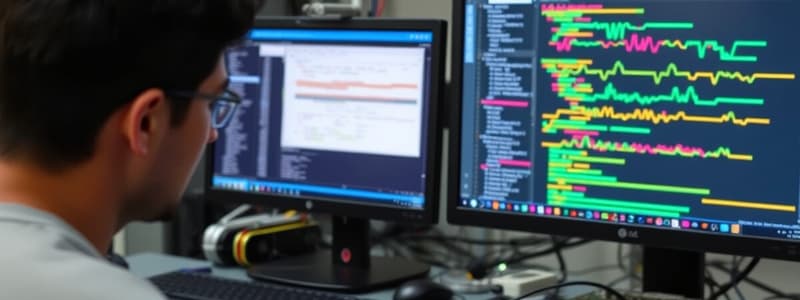Podcast
Questions and Answers
What is the definition of hardware?
What is the definition of hardware?
- User interface elements
- Layered software development
- Computer built out of wires, rollers, and motors (correct)
- Instructions computers perform
What does software refer to?
What does software refer to?
- Networking protocols
- User interfaces
- Collective term for programs (correct)
- Physical components of a computer
What is user experience?
What is user experience?
The virtual world presented by hardware and software that we experience.
What defines a software stack?
What defines a software stack?
Define algorithms.
Define algorithms.
What does feedback indicate?
What does feedback indicate?
What is a consistent interface?
What is a consistent interface?
What is a new instance?
What is a new instance?
What is perfect reproduction in digital information?
What is perfect reproduction in digital information?
What is copying and pasting?
What is copying and pasting?
What represents metaphors in computing?
What represents metaphors in computing?
What is a graphical user interface?
What is a graphical user interface?
Define synchronous communications.
Define synchronous communications.
What are asynchronous communications?
What are asynchronous communications?
What are the types of communications by the number of receivers?
What are the types of communications by the number of receivers?
Study Notes
Hardware and Software
- Hardware consists of physical components such as wires, rollers, and motors in a computer system.
- Software refers to the set of programs that direct a computer to perform specific tasks and applications.
User Experience
- The interaction between hardware and software creates a virtual experience distinct from the computer's actual operations.
Software Development
- The Software Stack utilizes a layered approach, where higher-level programs depend on lower-level operations and code established by earlier programmers.
Algorithms and Feedback
- Algorithms are systematic methods designed to achieve specific outcomes.
- Feedback indicates whether a computer is processing a request or has completed it.
User Interface Consistency
- A consistent user interface enhances user-friendliness through familiar icons and menu systems.
Digital Reproduction
- Digital files are perfectly reproducible thanks to binary code, distinguishing them from mediums like vinyl records.
Communication Types
- Synchronous communications require simultaneous participation from sender and receiver (e.g., phone calls).
- Asynchronous communications allow for time-separated sending and receiving (e.g., texts).
Networking and Transmission
- Internet communications rely on a Client/Server Structure, where users (clients) request data from stored servers.
- IP Addresses uniquely identify each device on the Internet, comprising four numbers between 0 and 255.
Domain Names and DNS
- Domain names simplify internet navigation by avoiding complex IP addresses, such as rutgers.edu.
- DNS servers function hierarchically to name and locate computers within the network.
Wide Area and Local Area Networks
- WANs facilitate communication across vast distances, while LANs connect nearby computers via Ethernet cables.
Internet Connectivity
- Connections to the Internet can be established through Internet Service Providers (ISPs) or via local campus networks.
Wireless Technology
- Wireless networks operate on the 802.11 protocol, allowing devices to connect without physical cables.
World Wide Web
- The WWW encompasses all web servers and content online, facilitated by specific protocols like HTTP.
HTML Structure
- HTML defines web pages with tags for structuring content and formatting text, allowing nonlinear documents ideal for web viewing.
- HTML5 introduces new tags:
,
Link Creation
- Hyperlinks consist of anchor text (visible link) and URLs pointing to other pages, enhancing web navigation.
Data Searching and Crawlers
- Crawlers index web pages to gather data for search engines, focusing on descriptive terms within HTML tags to rank results.
Color Digitization
- RGB colors are represented with binary numbers, requiring one byte per color and three bytes for pixel representation.
Sound Digitization
- Sound is digitized through sampling, capturing waveforms at intervals to create an accurate digital signal.
Image and Video Compression
- JPEG employs lossy compression to reduce image file sizes by exploiting human visual perception characteristics.
Video Formats
- MPEG applies similar principles to JPEG for motion pictures, creating efficient video storage and playback solutions.
Color Representation in Monitors
- Monitors can be categorized by color capabilities:
- Monochrome displays only two colors.
- Gray-scale monitors show multiple shades of gray.
- Color monitors can represent millions of colors using separate red, green, and blue channels.
Studying That Suits You
Use AI to generate personalized quizzes and flashcards to suit your learning preferences.
Description
Prepare for your Comp Apps for Business Exam #1 with these flashcards. Each card provides key terms related to computer hardware, software, and user experience, helping you understand the core concepts essential for the exam. Perfect for quick review and study sessions.




